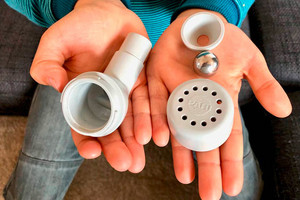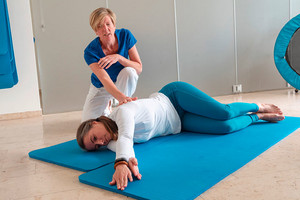There are many reasons why mucus can accumulate in the lungs. Whatever the reason, mucus disrupts lung function and should ideally be cleared as gently as possible and transported out of the lungs. There are several options for those who do not want to take medication or oral mucolytics.
It is not recommended to simply remove the mucus by coughing hard. While coughing is a natural reflex that removes foreign bodies, accumulated mucus and other harmful irritants from the lungs and should not be suppressed, coughing very hard is not a gentle approach and puts the bronchial tubes under strain, which can lead to painful straining of the muscles of respiration. Therefore our first tip is to avoid coughing fits.
Mucus that is lodged in the lungs can in many cases be cleared gently. Our tips can help both patients with chronic lung diseases and those with acute respiratory infections. We therefore advise to always have a doctor clarify what is causing the build-up of mucus in the lungs.
Tip 1: Avoid coughing hard and breathe away coughing fits
A cough and in particular coughing fits can place a great strain on the bronchial tubes and can damage them. Frequent and repeated coughing fits impact the elasticity of the bronchial tubes, cause them to stretch out of shape, so to speak. Patients with chronic lung disease who have frequent coughing fits are especially affected, so it is best to suppress the urge to cough whenever possible and to breathe it away. Yes, that’s totally doable! Here’s how!
If you notice the urge to cough, hold your breath, close your mouth and, if you need to, press your lips firmly together. Try to resist the pressure and the irritation. Once the worst of the irritation has passed, try to breathe quickly in and out through your nose with shallow breaths, as if you were panting through your nose. Carry on breathing like this until the urge to cough has passed and you can breathe calmly again. You can then breathe up the mucus by breathing out quickly with your mouth wide open. Say “haff” as you breathe out. Now you can cough if you like, to shift the mucus. What is important is that you avoid coughing fits wherever possible, although this is not something that can always be achieved.

Tip 2: Autogenic drainage, pursed lip breathing and PEP systems
Autogenic drainage is a special breathing technique to clear mucus from the lungs and to gently transport it towards the mouth. “PEP” systems such as the PARI O-PEP also help loosen the mucus in the lungs. A rotating ball inside the auxiliary device causes the air to vibrate; these vibrations are then transferred to the mucus in the bronchial tubes as you breathe out. This vibration loosens the mucus from the bronchial walls. The PARI O-PEP is suitable for adults and children. It is available in pharmacies or online. Patients with chronic respiratory diseases can ask for a prescription for the O-PEP.
Tip 3: Drink plenty
Make sure you drink enough! This helps keep the mucus as liquid as possible and makes its removal from lungs easier and gentler. Drinking something is also a good tip to prevent an oncoming coughing fit or to mitigate one once it has started.

Tip 4: Positioning and mobilization exercises for the chest
Mucus is easily cleared when air can get behind the secretions and the mucus can detach from the bronchial walls. Mobilisation exercises and positioning, such as the bow and arrow exercise and the screw and the fish exercises can help achieve this. The PARI blog has the best exercises to clear mucus. Ideally, you should do these exercises before your inhalation therapy. This liquifies the mucus a little in advance and makes it easier to clear.
Tip 5: Inhalation therapy with a nebuliser
Inhalation with a nebuliser is a very effective and trusted method to moisten the bronchial membranes and mucus in the lungs. This helps transport the secretions, making it easier to remove the mucus out of the lungs. Inhalation therapy is equally suited for patients with chronic lung disease and for those with acute respiratory diseases. Adults, children and even babies can use inhalation therapy. Doctors can prescribe inhalation and an inhalation device to treat acute bronchitis, for example. Usually a saline solution is used for the inhalation. While isotonic saline solutions (NaCl 0.9%), such as the PARI NaCl 0,9% inhalation solution moistens the airways, hypertonic saline solutions with a higher salt content clear the mucus.
Tip 6: Hypertonic inhalation solutions
Unlike isotonic saline solutions (0.9% salt content), hypertonic solutions have a higher concentration of salt. This high salt content more effectively liquifies the mucus. This then means that the secretion can be coughed up more gently.
PARI offers 2 hypertonic saline solutions for inhalation therapy - MucoClear 3% and MucoClear 6%.
How to obtain inhalation solutions in the pharmacy or online shops. In certain cases the doctor can also prescribe hypertonic saline solutions.

Tip 7: Chest vibration and pinching
During or after inhalation, you can better mobilise the mucus in the lungs and gently draw it upwards even more effectively by chest vibrations and pinching. For chest vibration, put your hands on your chest at the point where you can feel the mucus. As you breathe out, exert light pressure and create vibration motions with your hands on your chest. The vibrating shaking sets the mucus in the lungs in motion and makes it easier to clear.
You may also be interested in these topics:
An article written by the PARI BLOG editorial team.
© 2025 PARI GmbH Spezialisten für effektive Inhalation